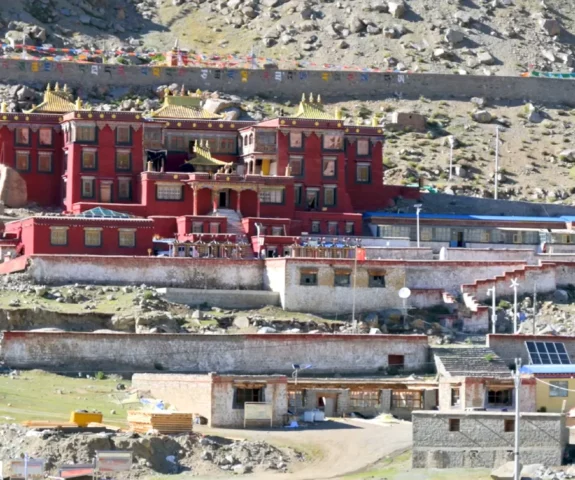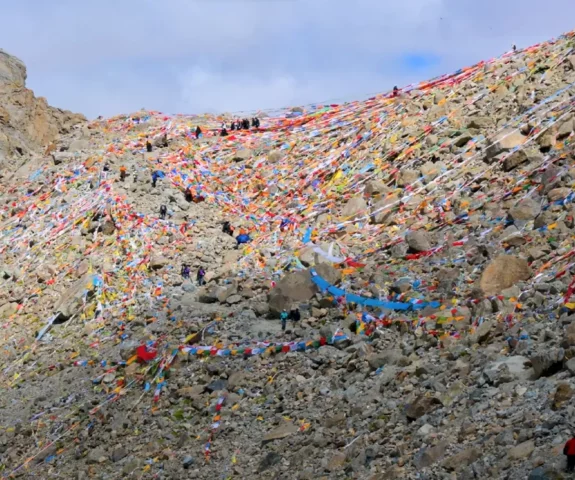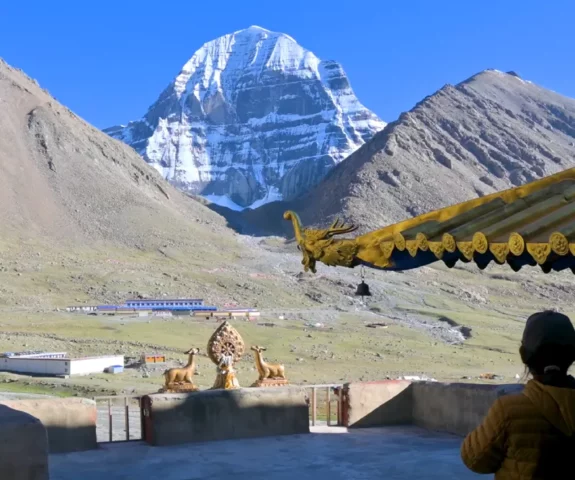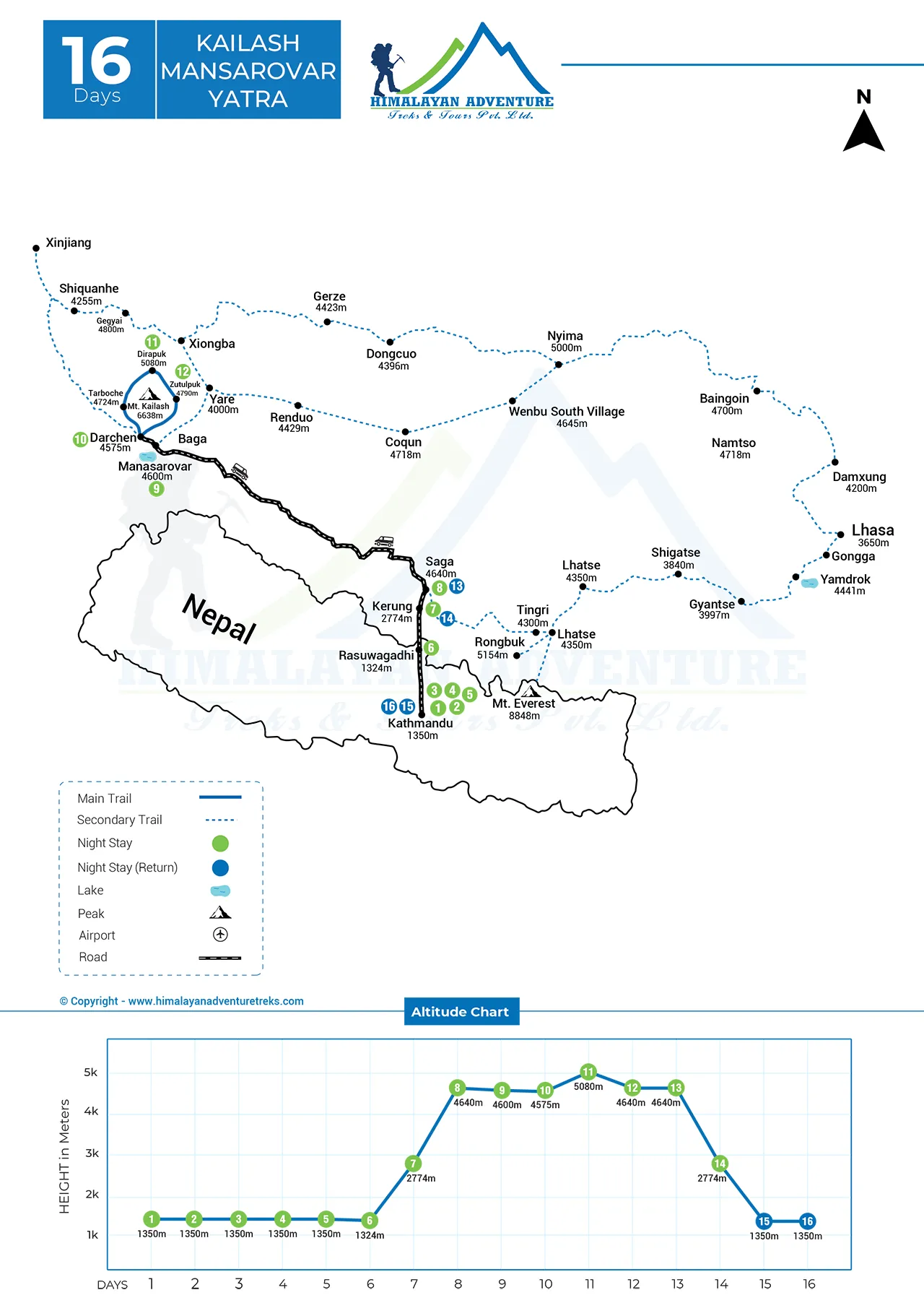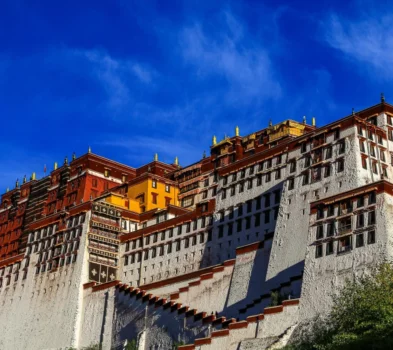Duration
16 DaysKailash Mansarovar Yatra
Trip Grade
ModerateGroup Size
4-35 PeopleMax Altitude
5,630m. / 18,471ft.Best Season
May- SeptemberActivity
Pilgrimage TourMeals
Breakfast, Lunch & DinnerAccommodation
Hotels & Guest HousesTransportation
Bus & JeepTrip Customization
On request (click here)Highlights of Kailash Mansarovar Yatra
-
Sacred Mount Kailash Pilgrimage: Experience the spiritual journey to Mount Kailash, believed to be the abode of Lord Shiva, attracting Hindu, Buddhist, Jain, and Bon pilgrims worldwide.
-
Holy Mansarovar Lake: Visit Lake Mansarovar, one of the highest freshwater lakes in the world, known for its serene beauty and spiritual purification rituals.
-
Kailash Parikrama Trek: Complete the Kailash Kora trek, a 52 km circuit around Mount Kailash, considered a life-changing spiritual experience.
-
Asthapad and Yam Dwar Visit: Explore Asthapad and pass through Yam Dwar, the “Gateway of the God of Death,” marking the start of your spiritual transformation.
-
Tibet Overland Journey: Enjoy a scenic overland drive from Nepal to Tibet, crossing dramatic landscapes and high-altitude passes like the Nyalam and Saga regions.
-
Spiritual Significance of Kailash: Mount Kailash is regarded as the axis of the world (axis mundi), where heaven meets earth, and is deeply revered in Hindu mythology and Tibetan Buddhism.
-
Altitude Adventure to Kailash: Embark on a high-altitude journey reaching over 5,600 meters at Dolma La Pass, one of the highest points on the Kailash trek.
-
Nepal to Kailash Mansarovar Tour Packages: Choose from various Kailash Mansarovar Yatra packages from Nepal, including helicopter tours, luxury options, and group departures.
-
Full Moon at Mansarovar: Experience Purnima (full moon) at Mansarovar Lake, believed to multiply the spiritual benefits of the Yatra and attract thousands of pilgrims.
-
Kailash Yatra by Helicopter: Opt for a shorter and more comfortable journey with the Kailash Mansarovar Yatra by helicopter, ideal for elderly or time-bound travelers.
Trip Introduction
“Travelling the road will tell you more about the road than Google tells you about the road.” Kailash Mansarovar Yatra is known as the mother of all Teertha Sthal. The holy Mount Kailash & Manasarovar yatra is considered to be one of the most difficult Pilgrimage trails in Asia. Located in the far reaches of western Tibet, the north part of Nepal, and India.
Kailash Mansarovar Yatra is one of the most sacred mountains in the world, with the most prominent diamond-shaped symmetrical peak height of 6,638m (21178 ft), and is made up of black solid rock. It is one of the highest parts of the Himalayas and serves as a source of some of the longest rivers in Asia. Mt. Kailash is also known as Gang Tise or Gang Rinpoche in the Tibetan language.
Mt. Kailash & Manasarovar Lake have become an important pilgrimage for four faiths: Buddhists, Jains, Hindus, and the Tibetan religion of Bon. To the Buddhists, Kailash is associated with a tantric meditational deity called Demchog and his consort Samding Dorje Phagmo. The beautiful and holy lake Mansarovar, where a ritual bath will deliver a pilgrim to Brahma’s paradise, and a drink of its waters will relinquish the sins of a hundred lifetimes.
For many years, people have made the Kailash Mansarovar a pilgrimage destination from all over the Asian continent to see this mountain. Besides the people of Tibet, people from all parts of India, Bhutan, Nepal, Central Asia, and even Western countries have devotedly made the journey to Mount Kailash & Mansarovar Lake yatra.
At Himalayan Adventure Treks, we provide you with the best services on this Tour. We also have skilled and licensed guides to lead you on the trip. Likewise, we also have other trips to Nepal and Bhutan.
The Kailash Mansarovar Yatra is a sacred pilgrimage that holds immense spiritual significance for followers of Hinduism, Buddhism, Jainism, and Bon traditions. Situated in the remote Tibetan plateau, Mount Kailash (6,638 meters/21,778 feet) is revered as the spiritual center of the universe and the abode of Lord Shiva in Hindu belief. The Kailash Yatra also includes Lake Mansarovar, a pristine freshwater lake at 4,590 meters (15,059 feet), which is believed to cleanse sins and bestow spiritual enlightenment.
Pilgrims often start their journey from Kathmandu, exploring the cultural richness of the Kathmandu Valley, including UNESCO World Heritage Sites like Pashupatinath Temple and Swayambhunath Stupa. The adventure begins with a drive to Rasuwagadhi, the border town connecting Nepal and Tibet, where pilgrims cross into Tibet and continue to the vibrant town of Kerung. The journey through Tibet offers breathtaking views of the Himalayan ranges, including peaks like Shishapangma and Gurla Mandhata.
As the pilgrimage progresses, the yatra reaches Saga, a high-altitude town that is a resting point to acclimatize before continuing to Lake Mansarovar. The lake, surrounded by snow-capped peaks and blessed with crystal-clear waters, is a key pilgrimage highlight. Many devotees take a holy dip in its waters and perform rituals along the lakeshore, seeking blessings and spiritual cleansing.
The journey advances to Darchen, the base camp for Mount Kailash Kora, a circumambulation trek considered a lifetime achievement for devotees. The trek spans three days, covering 52 kilometers (32 miles), starting at Darchen and passing through significant points like Derapuk and Zutulpuk Monastery. The route takes pilgrims across the challenging Droma La Pass at 5,630 meters (18,471 feet), the trek’s highest point.
The north face of Mount Kailash at Derapuk offers an awe-inspiring sight, where pilgrims meditate and soak in the serene atmosphere. Along the route, pilgrims encounter prayer flags, Mani walls, and local Tibetan communities, adding cultural depth to the spiritual journey.
The yatra is physically demanding, requiring stamina and preparation, especially due to the high altitudes and rugged terrains. Despite the challenges, the journey is spiritually rewarding, offering moments of introspection, devotion, and connection with nature. The pilgrimage concludes with the return drive to Kathmandu, where pilgrims reflect on their transformative experience.
The Kailash Mansarovar Yatra combines spiritual devotion, natural beauty, and cultural exploration, making it a once-in-a-lifetime journey. It connects the sacred energy of Mount Kailash and Lake Mansarovar with the rich traditions and breathtaking landscapes of Nepal and Tibet.
Outline Itinerary of Kailash Mansarovar Yatra
Day 01: Arrival at Kathmandu Airport.
Day 02: Submit Passport and Kathmandu Valley Sightseeing.
Day 03: Patan and Bhaktapur Durbar Square Exploration.
Day 04: Chandragiri Cable Car Visit.
Day 05: Gear Preparation and Free Day.
Day 06: Drive from Kathmandu to Rasuwagadhi.
Day 07: Cross Border and Drive to Kerung.
Day 08: Drive from Kerung to Saga.
Day 09: Drive from Saga to Lake Mansarovar.
Day 10: Drive from Mansarovar to Darchen.
Day 11: Trek from Darchen to Derapuk.
Day 12: Trek to Zutulpuk via Droma La Pass.
Day 13: Trek back to Darchen and Drive to Saga.
Day 14: Drive back to Kerung.
Day 15: Cross Border and Drive Back to Kathmandu.
Day 16: Departure from Kathmandu.
Our guests sharing their experiences (Photo/Video Gallery)
Detail itinerary of Kailash Mansarovar Yatra
Day 01: Arrival at Kathmandu Airport.
Your journey begins with your arrival at Tribhuvan International Airport in Kathmandu, the bustling capital of Nepal, situated at an altitude of 1,400 meters (4,593 feet). After completing immigration and customs formalities, you will be warmly greeted by your travel representative and escorted to your hotel. Kathmandu, known for its rich cultural heritage and vibrant streets, offers a perfect start to this spiritual adventure. Once you settle in, you’ll have some time to relax and recover from your travels. In the evening, a detailed briefing about the Kailash Mansarovar Yatra will be held to prepare you for the upcoming journey. If energy permits, explore the lively streets of Thamel, a hub for trekkers and pilgrims. End the day with a delicious traditional Nepali dinner accompanied by cultural dance performances, immersing yourself in the local atmosphere.
Activity: Airport Pickup, 30 min
Max. Altitude: 1,400m/4,593ft. Kathmandu
Meal: Breakfast
Accommodation: Hotel
Day 02: Submit Passport and Kathmandu Valley Sightseeing.
The day begins with the submission of your passport for visa processing, allowing you to focus on exploring the Kathmandu Valley. Your sightseeing tour covers some of the most iconic UNESCO World Heritage Sites. First, visit Pashupatinath Temple, a sacred Hindu pilgrimage site by the Bagmati River, revered for its spiritual significance. Next, head to Boudhanath Stupa, one of the largest stupas globally, where the serene chants of Buddhist monks create a tranquil environment. The tour continues to Swayambhunath Stupa, also known as the Monkey Temple, offering panoramic views of Kathmandu Valley. Finally, visit Budhanilkantha Temple, home to a reclining Vishnu statue that attracts both Hindus and curious travelers. With a driving distance of 20 kilometers (12.4 miles), this enriching day of exploration showcases Kathmandu’s blend of spirituality and heritage.
Activity: Sightseeing, 5-6 hours
Max. Altitude: 1,400m/4,593ft. Kathmandu
Meal: Breakfast, Lunch & Dinner
Accommodation: Hotel
Day 03: Patan and Bhaktapur Durbar Square Exploration.
Begin your journey into Nepal’s ancient art and architecture by exploring Patan Durbar Square, located at 1,350 meters (4,429 feet). Known for its exquisite temples and palaces, Patan is a treasure trove of Newari craftsmanship. Admire the intricate carvings of Krishna Mandir and explore the Golden Temple, each narrating stories of Nepal’s rich cultural past. From here, proceed to Bhaktapur Durbar Square, a medieval city known for its timeless charm and traditional lifestyle. At an altitude of 1,400 meters (4,593 feet), Bhaktapur features architectural marvels like the Nyatapola Temple and 55-Window Palace. Savor local Newari delicacies such as “Juju Dhau,” the famous King of Yogurts, and watch artisans demonstrate pottery-making and wood carving. This day’s experiences, covering a driving distance of 35 kilometers (22 miles), are a deep dive into Nepal’s glorious history and culture.
Activity: Sightseeing, 5-6 hours
Max. Altitude: 1,400m/4,593ft. Bhaktapur
Meal: Breakfast, Lunch & Dinner
Accommodation: Hotel
Day 04: Chandragiri Cable Car Visit.
This day offers a refreshing escape as you visit Chandragiri Hills, situated at 2,551 meters (8,370 feet). A short drive of 12 kilometers (7.5 miles) takes you to the cable car station. The ride offers breathtaking views of the Kathmandu Valley, with glimpses of the majestic Himalayan peaks in the distance. Upon reaching the hilltop, you can visit the Bhaleshwor Mahadev Temple, an important spiritual site for Hindu pilgrims. The serene environment, combined with stunning panoramic vistas, makes it an ideal location for photography and meditation. Spend the day soaking in the natural beauty, enjoying fresh mountain air, and perhaps indulging in local snacks at the hilltop cafe. This day is perfect for rejuvenation and preparation for the more challenging phases of the journey ahead.
Activity: Sightseeing, 4-5 hours
Max. Altitude: 2,100m/6,890ft. Kathmandu
Meal: Breakfast, Lunch & Dinner
Accommodation: Hotel
Day 05: Gear Preparation and Free Day.
This day is dedicated to final preparations for the Kailash Mansarovar Yatra. Spend time reviewing your trekking gear and ensuring you have all the essentials for the high-altitude pilgrimage. Kathmandu’s Thamel area, with its numerous trekking shops, is the perfect place to purchase any missing items. Use this free day to acclimatize and explore the local culture at your own pace. You can visit nearby temples, try authentic Nepali cuisine, or simply rest to conserve energy. This day ensures you are physically and mentally ready for the adventure that lies ahead.
Activity: preparation day
Max. Altitude: 1,400m/4,593ft. Kathmandu
Meal: Breakfast, Lunch & Dinner
Accommodation: Hotel
Day 06: Drive from Kathmandu to Rasuwagadhi.
Depart early in the morning for a scenic drive to Rasuwagadhi, the Nepal-China border, situated at an altitude of 1,450 meters (4,757 feet). Covering a distance of 122 kilometers (76 miles), the drive takes 6–7 hours through winding mountain roads. The journey is filled with picturesque views of terraced fields, lush valleys, and cascading rivers. The Langtang mountain range occasionally graces the skyline, providing a glimpse of the Himalayan grandeur. Upon arrival, check into your lodge and rest, preparing for the border crossing into Tibet the following day.
Activity: Drive, 7-8 hours,
Max. Altitude: 1,450m/4,757ft. Rasuwagadhi
Meal: Breakfast, Lunch & Dinner
Accommodation: Lodge
Day 07: Cross Border and Drive to Kerung.
Begin the day with immigration formalities at Rasuwagadhi before crossing into Tibet. Once in the Chinese territory, proceed to the town of Kerung, located at an altitude of 2,800 meters (9,186 feet). The drive, covering a short distance of 30 kilometers (19 miles), takes about 1–2 hours. As you ascend, the landscape transforms into the vast Tibetan plateau with breathtaking views of snow-capped peaks. Spend the rest of the day acclimatizing to the higher altitude, exploring Kerung’s serene surroundings, and preparing for the journey deeper into Tibet.
Activity: Drive & Sightseeing, 5-6 hours
Max. Altitude: 2,800m/9,186ft. Kerung
Meal: Breakfast, Lunch & Dinner
Accommodation: Lodge
Day 08: Drive from Kerung to Saga.
Your journey continues with a long drive from Kerung to Saga, covering a distance of 240 kilometers (149 miles) over 5–6 hours. Saga is situated at an altitude of 4,640 meters (15,223 feet), marking a significant gain in elevation. The route takes you across the dramatic Tibetan plateau, characterized by wide valleys, towering peaks, and pristine rivers. You’ll cross several small Tibetan villages, offering glimpses into the local way of life. Along the way, you’ll traverse the high-altitude pass of Lalung La, which provides awe-inspiring views of the Himalayas, including peaks like Shishapangma. Upon arrival in Saga, settle into your accommodation, and take time to acclimatize, as the increasing altitude may require some adjustment. The serene beauty of Saga, surrounded by barren hills and vast plains, sets the stage for the spiritual and scenic wonders to come.
Activity: Drive, 5-6 hours
Max. Altitude: 4,640m/15,223ft. Saga
Meal: Breakfast, Lunch & Dinner
Accommodation: Lodge
Day 09: Drive from Saga to Lake Mansarovar.
Today, you’ll embark on a mesmerizing drive to the sacred Lake Mansarovar, covering 370 kilometers (230 miles) over 7–8 hours. Lake Mansarovar, located at an altitude of 4,590 meters (15,059 feet), is one of the holiest lakes in Tibetan Buddhism and Hinduism. The journey offers stunning views of the Gurla Mandhata range, with its snow-clad peaks reflected in the lake’s clear blue waters. Pilgrims believe that a dip in the lake cleanses sins and cures ailments. Upon arrival, spend time walking along the lakeshore, meditating, or simply taking in the tranquil atmosphere. The pristine beauty and spiritual energy of Mansarovar are awe-inspiring, making this a deeply moving experience for all visitors.
Activity: Drive, 7-8 hours
Max. Altitude: 4,590m/15,059ft. Mansarovar
Meal: Breakfast, Lunch & Dinner
Accommodation: Lodge
Day 10: Drive from Mansarovar to Darchen.
The drive from Lake Mansarovar to Darchen, the base camp for Mount Kailash circumambulation (Kora), is relatively short, covering 40 kilometers (25 miles) in about 1 hour. Darchen, at an altitude of 4,575 meters (15,010 feet), serves as the starting point for the Kora. After breakfast by the lake, you’ll travel through the rugged Tibetan landscape to reach this small town nestled at the base of Mount Kailash. Upon arrival, you can explore Darchen, purchase any last-minute supplies, and prepare for the trek ahead. The rest of the day is free for rest and acclimatization, ensuring you are ready for the physically demanding Kora.
Activity: Drive, 1 hour
Max. Altitude: 4,575m/15,010ft. Darchen
Meal: Breakfast, Lunch & Dinner
Accommodation: Lodge
Day 11: Trek from Darchen to Derapuk.
Today marks the beginning of the Kora, a sacred circumambulation around Mount Kailash. Starting from Darchen, you’ll trek 18 kilometers (11 miles) to Derapuk at an altitude of 4,900 meters (16,076 feet). The trek takes 6–7 hours, following a well-defined path that winds through the breathtaking Tibetan landscape. Along the way, you’ll pass through lush meadows, flowing streams, and ancient prayer flags fluttering in the wind. As you approach Derapuk, the awe-inspiring north face of Mount Kailash comes into view, leaving you spellbound with its majestic beauty. Pilgrims consider this a sacred spot for prayer and meditation. Spend the night at a basic lodge, reflecting on the spiritual significance of this trek.
Activity: Trek, 6-7 hours
Max. Altitude: 4,900m/16,076ft. Derapuk
Meal: Breakfast, Lunch & Dinner
Accommodation: Lodge
Day 12: Trek to Zutulpuk via Droma La Pass.
The trek from Derapuk to Zutulpuk is the most demanding day of the Kora, covering 22 kilometers (13.7 miles) in 9–10 hours. You’ll cross the Droma La Pass at 5,630 meters (18,471 feet), the highest point of the pilgrimage. The ascent is steep and requires physical endurance, but the panoramic views and spiritual significance make it worthwhile. Pilgrims leave offerings and prayers at the pass, creating a deeply moving experience. The descent leads to Zutulpuk at an altitude of 4,835 meters (15,862 feet), home to the famous Zutulpuk Monastery. The day’s journey ends with a sense of accomplishment and spiritual fulfillment.
Activity: Trek, 9-10 hours
Max. Altitude: 5,630m/18,471ft. Zutulpuk
Meal: Breakfast, Lunch & Dinner
Accommodation: Lodge
Day 13: Trek back to Darchen and Drive to Saga.
The final leg of the Kora takes you on a 14-kilometer (8.7-mile) trek back to Darchen, which takes about 4–5 hours. The path is relatively flat and easy compared to previous days, offering time for reflection and gratitude. Upon reaching Darchen, you’ll drive 370 kilometers (230 miles) back to Saga, a journey of 7–8 hours. The drive retraces the route through the stunning Tibetan plateau, providing one last opportunity to soak in its beauty. Spend the night in Saga, celebrating the completion of the Kora.
Activity: Trek & Drive, 4-5 hours
Max. Altitude: 4,640m/15,223ft. Saga
Meal: Breakfast, Lunch & Dinner
Accommodation: Hotel
Day 14: Drive back to Kerung.
The drive from Saga to Kerung covers 240 kilometers (149 miles) in 5–6 hours. As you descend in altitude, the changing landscapes—from the arid Tibetan plateau to lush green valleys—create a captivating contrast. Kerung, at an altitude of 2,800 meters (9,186 feet), offers a comfortable stop before crossing the border. Spend the evening reflecting on the journey and preparing for re-entry into Nepal.
Activity: Drive, 5-6 hours
Max. Altitude: 2,800m/9,186ft. Kerung
Meal: Breakfast, Lunch & Dinner
Accommodation: Hotel
Day 15: Cross Border and Drive Back to Kathmandu.
After completing border formalities at Kerung, you’ll drive 140 kilometers (87 miles) back to Kathmandu, a journey of 7–8 hours. The route follows winding mountain roads with spectacular views of the Himalayas and lush forests. Upon reaching Kathmandu, check into your hotel and rest. The evening is free to explore the city, shop for souvenirs, or enjoy a farewell dinner at a traditional Nepali restaurant.
Activity: Drive, 7-8 hours
Max. Altitude: 1,400m/4,593ft. Kathmandu
Meal: Breakfast, Lunch & Dinner
Accommodation: Hotel
Day 16: Departure from Kathmandu.
On your final day, you’ll be transferred to Tribhuvan International Airport for your departure. As you leave the vibrant city of Kathmandu, you’ll carry memories of the spiritual journey, the breathtaking landscapes, and the cultural richness of Nepal and Tibet. This marks the end of your transformative Kailash Mansarovar Yatra, a journey that leaves an indelible mark on your soul.
Activity: Airport drop, 30 min
Max. Altitude: 1,400m/4,593ft. Kathmandu Airport
Meal: Breakfast
Note:
If you have your own private group and want to make your trip private, we can run the custom trip all the day as per your requirements and group size.
Includes and Excludes
What are included with package?
- Three Nights 3 to 4-star Hotel in Kathmandu on Map Plan: Comfortable accommodation with veg meals included.
- Pick Up and Drop by Private Vehicle: Private transport for airport transfers in Kathmandu.
- Private Sightseeing Tour in Kathmandu with an Experienced Tour Guide: A guided tour of the key attractions in Kathmandu.
- All Necessary Transfers in Kathmandu (Arrival/Departure): Transport arrangements for your arrival and departure within Kathmandu.
- Kathmandu-Kyrung-Kathmandu Transfers by Private Vehicle: Private vehicle transfer between Kathmandu and Kodari.
- Tibet Group Visa & All Necessary Permits: Visa arrangement and the necessary permits for entry into Tibet, including permits for the Parikrama of Kailash and Mansarovar.
- Standard Hotel for the Rest of the Tour: Accommodation in standard hotels throughout the rest of the trip.
- Accommodation in Kailash in a Guesthouse (Dormitory Room): Basic guesthouse accommodation in Kailash.
- Transportation in Tibet: All necessary transport within Tibet, including road travel.
- Supporting Truck to Carry Logistics: A truck will carry all logistical supplies during the journey.
- English-Speaking Tibetan Guide: A professional guide fluent in English to assist you throughout the tour.
- Yaks & Yak Men During the Parikrama: Yaks and their handlers will help carry food, equipment during the Parikrama around Kailash.
- Entry Fees (Kailash & Mansarovar): All applicable fees for entering Kailash and Mansarovar.
- Medical Kit Bag & Oxygen for Emergency Use: A medical kit and oxygen for emergencies, ensuring safety during the trek.
- All Applicable Taxes and Service Charges: Taxes and service charges are included in the package price.
What are not included with package?
- Air Ticket to Kathmandu & Return: International flight costs to and from Kathmandu are not included.
- Entrance Fee in Kathmandu: Entrance fees to monuments and attractions in Kathmandu are not included.
- Nepal Re-entry Visa Fee: Any fees for re-entering Nepal (if applicable) are not covered.
- Your Travel Insurance: Travel insurance covering health, accidents, and unforeseen circumstances must be arranged separately.
- Porter and Horses: Personal belongings carried during the Parikarima horse, yak, and porter are not included.
- Rescue and Evacuation Service: Costs related to rescue or evacuation services are not covered.
- Personal Expenses: Expenses such as phone calls, laundry, souvenirs, etc., are not included.
- Horse for Riding During the Parikrama: If you wish to use a horse for the Parikrama, this will incur an additional charge.
- Bottled Drinks & Beverages: Beverages (including bottled drinks and alcoholic drinks) are not included.
- Tip for Guide & Driver: Tips for the guide, driver, and other staff are not included and are at your discretion.
- Extra Night Accommodation in Kathmandu in Case of Early Arrival from Kailash: If you arrive earlier than scheduled or need an extra night in Kathmandu, that will be at your own cost.
- Any Additional Costs (Transport, Hotel, Visa Split Charge) Due to Illness or Rescue of the Member: Any additional expenses arising from illness, emergency situations, or rescue services are not covered.
- Any Additional Costs Due to Natural Calamity and Unforeseen Circumstances: Extra costs incurred due to natural disasters or other unforeseen circumstances (such as delays, changes in schedule) are not included.
Pick Your Suitable Date
Book a Private Trip
Private & Group Discount Price
-
4 -
4 people
US$ 3500
-
5 -
10 people
US$ 3200
-
11 -
16 people
US$ 3000
-
17 -
25 people
US$ 2800
-
26 + people
9999
US$ 2600
Total Cost:
US$
Route Map & Altitude Chart
Kathmandu
Start/End point
Kathmandu
Trip Information
Key Highlights of the Kailash Mansarovar Yatra
Mount Kailash
Revered as the spiritual center of the universe and the abode of Lord Shiva, Mount Kailash (6,638 meters/21,778 feet) is sacred in Hinduism, Buddhism, Jainism, and Bon traditions. Its unique pyramid-shaped peak inspires awe and devotion.
Lake Mansarovar
Situated at an altitude of 4,590 meters (15,059 feet), this crystal-clear freshwater lake is considered the holiest lake in the world. Devotees believe a dip in its waters cleanses sins and promotes spiritual enlightenment.
Kora (Circumambulation) of Mount Kailash
The 52-kilometer (32-mile) trek around Mount Kailash, known as the Kora, is a once-in-a-lifetime spiritual journey. Highlights of the trek include Derapuk, Zutulpuk Monastery, and crossing the challenging Droma La Pass (5,630 meters/18,471 feet).
Droma La Pass
The highest point of the trek offers panoramic views and is a spiritually significant part of the Kora. It is a place of prayer and reflection for pilgrims.
Breathtaking Landscapes
The journey offers stunning views of the Tibetan plateau, snow-capped peaks like Gurla Mandhata and Shishapangma, high-altitude desert terrains, and serene valleys.
Cultural Richness
Experience the unique Tibetan Buddhist culture, including prayer flags, Mani walls, and ancient monasteries such as Zutulpuk and Chiu Monastery.
Spiritual Cleansing
Rituals at Lake Mansarovar, meditative practices at Mount Kailash, and moments of introspection along the journey provide profound spiritual experiences.
Sacred Tibetan Monasteries
Visit monasteries like Zutulpuk, Derapuk, and Chiu Monastery, which offer insights into Tibetan Buddhist traditions and history.
Kathmandu Valley Heritage
Begin the journey by exploring UNESCO World Heritage Sites in Kathmandu, including Pashupatinath Temple, Swayambhunath (Monkey Temple), and Boudhanath Stupa, adding a cultural dimension to the pilgrimage.
Challenging Adventure
The trek around Mount Kailash is a physical and mental challenge, offering a sense of achievement and fulfillment upon completion.
Unique Flora and Fauna
Encounter rare Himalayan wildlife and vegetation, adding a natural touch to the spiritual journey.
Cross-Border Experience
Travel through the Nepal-Tibet border at Rasuwagadhi and explore the high-altitude Tibetan towns of Kerung and Saga, offering a mix of landscapes and cultural interactions.
Pilgrim Fellowship
The yatra attracts pilgrims from around the world, fostering a sense of community and shared spiritual devotion.
Serenity and Solitude
The remote location and tranquil environment provide a perfect setting for reflection and meditation.
Eco-Spiritual Connection
The pristine environment of Mount Kailash and Lake Mansarovar reinforces the connection between spirituality and nature.
Ancient Legends
Tales and myths associated with Mount Kailash and Lake Mansarovar enrich the spiritual significance of the journey.
Accessible Routes
The yatra offers a mix of driving and trekking routes, making it accessible to people with varying levels of physical fitness.
Guided Experience
Knowledgeable guides ensure a safe and meaningful pilgrimage, providing insights into the history, culture, and significance of each landmark.
Lifetime Transformation
The Kailash Mansarovar Yatra is not just a journey but a life-changing experience, blending devotion, adventure, and cultural exploration in a sacred landscape.
Popularity of the Kailash Mansarovar Yatra
The Kailash Mansarovar Yatra is renowned worldwide, drawing pilgrims, spiritual seekers, adventure enthusiasts, and nature lovers. It holds immense significance for:
- Hindus:
Mount Kailash is believed to be the abode of Lord Shiva and Goddess Parvati. Pilgrims consider circumambulating the mountain a way to seek blessings, wash away sins, and achieve spiritual liberation (moksha). - Buddhists:
Revered as the sacred site of Demchok (Chakrasamvara), Mount Kailash is significant in Tibetan Buddhism. The Kora (circumambulation) is a way to gain enlightenment and good karma. - Jains:
Known as Ashtapada, the mountain is believed to be where Rishabhadeva, the first Tirthankara of Jainism, attained liberation. - Bon Practitioners:
The Bon religion regards Mount Kailash as a sacred mountain where their founder, Tonpa Shenrab Miwoche, descended from heaven. - Adventure Enthusiasts:
The journey’s challenging terrain, high altitudes, and remote landscapes attract trekkers and adventure seekers looking for a unique and transformative experience.
Best Season for Kailash Mansarovar Yatra
The best time to undertake the Kailash Mansarovar Yatra is during the summer and early autumn months when the weather is most favorable:
- May to September:
- Weather Conditions: Clear skies, moderate temperatures, and less snowfall make trekking safer and more enjoyable.
- Visibility: The majestic views of Mount Kailash and Lake Mansarovar are at their best during this period.
- Key Highlights by Month:
- May to June: The beginning of the season, with relatively warmer days and manageable cold nights.
- July to August: Despite occasional monsoon rains in lower regions, the area around Mount Kailash remains accessible, making it suitable for pilgrims and trekkers.
- September: The weather becomes cooler, but the skies are clearer, offering stunning landscapes.
Procedure for Kailash Mansarovar Yatra
The journey requires thorough planning and specific arrangements due to its remote location and high-altitude challenges. Below is a step-by-step procedure for undertaking the yatra:
- Pre-Booking and Registration:
- Choose a reliable tour operator to organize your trip, including permits, accommodations, and transportation.
- Register for the yatra with government-approved agencies if traveling through India.
- Travel Permits:
- Obtain permits from the Tibet Autonomous Region for entry into Tibet and access to Mount Kailash and Lake Mansarovar.
- Indian pilgrims need a special visa issued by the Chinese Embassy.
- Health Check-Up:
- Undergo a comprehensive medical check-up to ensure fitness for high-altitude travel.
- Carry a doctor’s certification if required.
- Travel Insurance:
- Obtain insurance that covers high-altitude sickness, emergencies, and evacuation.
- Preparation and Packing:
- Pack appropriate clothing, trekking gear, and personal items for the harsh weather and terrain.
- Consult the equipment list for essential items.
- Journey Outline:
- Day 1-2: Arrival in Kathmandu or a designated starting point for acclimatization and sightseeing.
- Day 3-6: Drive to the Nepal-Tibet border, cross to Tibet, and travel to Lake Mansarovar.
- Day 7-13: Perform the Kora (circumambulation) around Mount Kailash, including the challenging trek over Droma La Pass.
- Day 14-17: Return journey to the starting point.
- Acclimatization:
- Allocate sufficient time for acclimatization to prevent altitude sickness, particularly before crossing high passes like Droma La (5,630 meters / 18,471 feet).
- Food and Accommodation:
- Basic accommodations in guesthouses or tents and vegetarian meals are provided throughout the yatra.
- Pilgrim Etiquette:
- Respect local customs, spiritual practices, and the pristine environment of the region.
- Emergency Preparedness:
- Be prepared for altitude sickness or medical issues with first aid kits, oxygen cylinders, and access to emergency evacuation services.
The Kailash Mansarovar Yatra is a life-changing journey that combines spirituality, adventure, and cultural exploration. Its popularity among diverse religious groups and the breathtaking natural beauty make it a must-visit destination for those seeking a transformative experience.
Essential Packing List for Kailash Mansarovar Yatra
Traveling is mostly about enjoying and experiencing the destination, however, if you want to get the most from your little holiday, then appropriate travel gear is also a must.
It may seem a chore to you, but some of the items and equipment are such that you would hate to be without them. Here, we have listed some must-have gear that will take up very small space in your backpack and is also legal to travel with.
- Your Passport
- Visa
- Passport Photos
- Local Currency
- Credit or Debit Cards
- Emergency Contact Info
- Booking Information
- Health Insurance
- First Aid Kit
The backpack is a more comfortable, easy-to-carry, manageable, and convenient option than carrying a heavy suitcase when traveling abroad. You can carry almost all your gear in it without much load. We suggest you have one main and another secondary backpack: the main backpack will have large storage for all your equipment and belongings, and the secondary backpack will be used to travel light during the day.
- Main Backpack: Good quality waterproof lightweight with volume up to 45 to 60 L with a good hip-belt
- Secondary Backpack: Foldable, durable, lightest, and smallest
- Foldable Travel Toiletry Bag
- Carrying case or waterproof cover for your main and secondary backpack to protect from dust, water, and dirt
- Camera Backpack
- Document bag
- Waterproof Jacket
- Light Down Jacket
- Rain Coat
- T-shirts (long and half-sleeved) and Tank Tops for the hot days
- Fleece Jackets
- Hoodie
- Sweatshirts
- Wool sweater
- Durable, lightweight, quick drying Hiking Pants
- Some Jeans for a casual look
- Canvas or cargo pants with numerous pockets
- Shorts
- Leggings for women
- Skirt (long for visiting temples and monasteries for women)
- Long Dress for some formal occasions
- Bras (Sports bras would be preferable for comfortable traveling)
- Panties
- Briefs
- Boxers
- Socks (Cotton and woolen, quick drying)
- Flip-flops or sandals
- Canvas sneakers
- Trail shoes for light walking and touring
- Hiking Boots
- Swimsuit
- Hat, cap
- Bandana and masks
- Scarf, shawl, or foulard
- Handkerchief
- Gloves
- Sleeping Bag, Hammock, Tent for nature trips ( Optional)
- Earplugs
- Inflatable pillow or cushion
- Sleeping with an eye mask
- Sunscreen or sunblock
- Sunglasses
- Chapsticks or Lip Balms
- Moisturizer
- Deodorant
- Light, quick-drying towel
- Phone with charger, headphones, memory cards
- Camera with replacement battery, memory cards, and charger
- Notebook computer, tablet
- GPS or GPS Watch
- Universal Adapter
- Power Bank
- Solar Charger
- Toothpaste
- Shampoo
- Toothbrush
- Comb
- Soap
- Hand sanitizer
- Sanitary Pads
- Padlocks
- Head torch
- Multipurpose knife
- Lighter or matches
- Whistle
- Thermal Blanket
- Flashlight
- Compass
- Mosquito spray or repellent
- Water Filter
- Antiseptics
- Painkillers such as Aspirin or Ibuprofen
- Bandages
- Tweezers
- Thermometer
- Disposable gloves
- Your prescribed medications
- Common medicines for diarrhea, nausea, and vomiting
- Anti-allergic medications
- Moleskin or blister pads
- Altitude sickness medication (Diamox)
- Eye and ear drops
- Safety Pins
- Gause Pads
- Scissors
Equipment Note:
- We understand that not every item that we have listed here is essential. The traveling items depend on what you need, your destination, the type of tour, and a number of days you have allocated for your tour.
- So, review our list and pack only what is necessary for you. The main aim is to travel as light as you can and comfortably without the burden of extra luggage. Most of the items here can even be purchased in Kathmandu, so there is no need to worry if you forget to pack something.
Frequently Asked Questions
What is Kailash Mansarovar Yatra?
A sacred Himalayan pilgrimage for Hindus, Buddhists, Jains & Bon followers to Mount Kailash and Lake Mansarovar, believed to cleanse sins and offer divine blessings.
Where is Mount Kailash located?
Located in Western Tibet, near Nepal and India, Mount Kailash stands at 6,638m and is considered the abode of Lord Shiva.
Best time to visit Kailash Mansarovar?
The ideal time is May to September, when the Kailash trek route is accessible and weather is stable for Mansarovar Yatra.
How to reach Kailash Mansarovar from Nepal?
Start from Kathmandu, drive to Rasuwagadhi, cross to Kerung (Tibet), then travel to Saga, Mansarovar, and Kailash.
Why is Lake Mansarovar sacred?
Mansarovar Lake is believed to cleanse sins of 100 lifetimes; pilgrims take a holy dip and perform rituals along the shore.
What is Mount Kailash Kora?
A 52 km circumambulation trek around Kailash, starting from Darchen, crossing Drolma La Pass (5,630m)—a spiritual and physical challenge.
Fitness needed for Kailash Yatra?
Good health, basic trekking fitness, and altitude sickness awareness are needed due to high elevation and rough terrain.
Religious beliefs of Kailash?
Sacred in Hinduism, Buddhism, Jainism, and Bon; believed to be the center of the spiritual universe
What is Charan Sparsh?
A short hike near Kailash base, Charan Sparsh is believed to grant divine blessings—a top spiritual spot in the Yatra.
Does Himalayan Adventure Treks offer this tour?
Yes, we provide guided Kailash Mansarovar Yatra packages from Nepal with full logistics and experienced staff.




